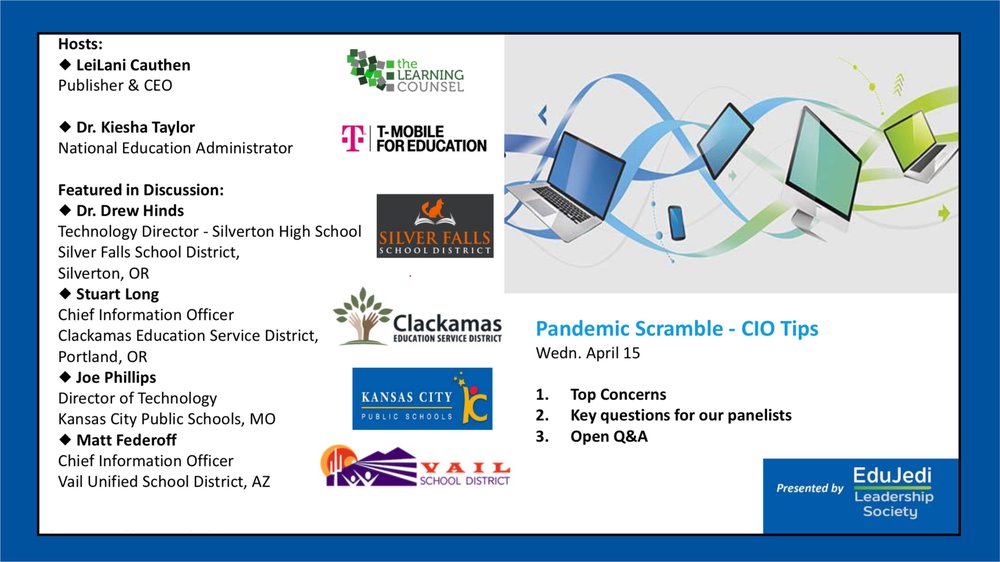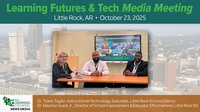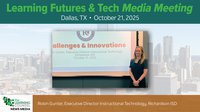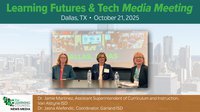Never has technology taken on a greater role in education, and at no time has there been more pressure to get it right. In this installment of the Learning Counsel’s Emergency National Virtual Discussion series, technology leaders from around the country talk about the steps they took to get it right and offer advice to districts across the nation.
In order to serve our students during this pandemic, Dr. Kiesha Taylor, the National Education Administrator for T-Mobile first looks at access. “A lot of times we have the conversation and we say, Oh, these students are at home. Who doesn’t have access at home? We need to get to a place where we are able to survey, survey and then survey again because this is a time where a lot of students in our marginalized populations are not necessarily at home. They're with relatives, they're with close family friends or the neighbor or their grandparents. So, there are so many other situations that are happening. As we think about serving students, what does home look like? What does home access look like? And then what does away access look like and which one will be more impactful for the student? And do we have to be in a position to choose? From a connectivity perspective, I think we have to make sure that our surveying is coming full circle also that we're redefining the student community.”
School closing and COVID-19 have brought up a number of connectivity and technology concerns within our districts, and generally, it is the IT department that has to work through and solve these concerns. LeiLani Cauthen, CEO and Publisher at the Learning Counsel explains the mad scramble. “There’s the operational continuity you're having to deal with in the tech side, what's essential and what you have to back burner, and sometimes barking at people like, ‘No, I'm not integrating that right now. I'm doing all this other stuff.’ So, there's that and then teeing up thousands of devices overnight. How are you going to pass those through a sterile environment and then, safe and secure hardware or power cord retrieval. Obviously single sign on, and what are you doing with help desks? We're getting a lot of information on the need for help desk, but not just the usual help desk because there's so much software in play right now.
“And then, what are you doing with your virtual training? Obviously in the IT side, there's a huge surge in interest in what you're doing with your security and privacy. You've got new apps, there's been a YouTube policy change that's freaking people out. There's Zoom and a lack of security, and other new policies including culture and behavior online. And then, networks, and equity of access is obviously huge. I think nationally it's bigger than we ever expected as we as we've been in this quarantine period. And then what are your capacities?”
Dr. Drew Hinds is the Technology Director Silverton High School at the Silver Falls School District. According to Hinds, “As we're talking about communication tools in particular, internal and external communication is one of the first things you've got to attend and spin up. Luckily, we had that spring break period where we were able to spin up the administrators, teachers and then families and focusing change management, defining what it is that we were talking about with some very specific language. This is not new to virtual charter schools that have been operating for more than a decade, but they use terms like synchronous and asynchronous, synchronous just being live meetings, asynchronous being not live. So just using technical language like that. And a two way in, one way, communication tools and just laying out and establishing those tools you'll use as a platform for communicating internally to kind of take the oxygen first to yourself and then help your neighbor.
“That's been the metaphor is to get those teachers and administrators starting to use the tools with their own process of spinning up. And then essentially moving to the point where they're supporting classified staff, who are of a support to them to moderate meetings and communicate with families as well as pass out meals and offer social emotional learning and supports and calls.”
Stuart Long, Chief Information Officer at Clackamas Education Service District said, “I'm at a service district, so we're a regional service center. We serve as 10 districts right outside Portland. So, we don't have the engagement with teachers at the depth that say Silver Falls does. We focus more on a regional level, but even at that level, trying to figure out a training regimen for staff that have no formalized experience or on a regular basis. I think in technology we take for granted how easy some of these tools like GoTo and Zoom and Meet are. But I think that for others it was a real challenge.
“I think it was a little bit in surprising, how scared some folks were to take that initial leap. But once they did, they realized that it grants the user extreme capacity to work remotely. And I think this is something that technologists in general and education have been talking about for decades now.”
Joe Phillips is the Director of Technology at Kansas City Public Schools. According to Phillips, “I think for us, we really broke the work down into three main areas for Kansas City Public Schools and we had to pivot extremely quickly to get to these three areas. For us, we had to make sure that staff could work from home. We had to make sure that students could learn from home. And because we have 100 percent free lunch, I very quickly found myself in the business of food distribution and using our technology tools and our data trends and tracking and dashboards and that kind of thing to be able to get food to our students. So, it was almost like we started three startup companies overnight in order to make all of this happen.”
Matt Federoff, Chief Information Officer at Vail Unified School District said, “20 years of hard work pays off. We already had 5,000 devices out in our district. We've been one-to-one for 15 years. We've been traditional textbook free for 10 years. So, it was a matter of going into the Google console and adding the Zoom extension to all of our student laptops. We have a unified LMS. I cannot overemphasize the utility and the value in having a single LMS, whatever that may be, you know, ‘One ring to rule them all.’ In that way, our teachers and our students and our parents weren't going off in 16 directions to do this and that and every other thing. And having teachers who were really trained in how to use it. So the first thing we did was immediately spin up three refresher classes in our LMS and we told our teachers, okay, you got to go to them.
“And they were all online and delivered online. We really are looking at this as a chance that on the other side of this, after the disruption, we're going to have a cohort of teachers and students who absolutely know how to do this. This is much like when online standardized testing came on seven or eight years ago. There were a lot of IT directors gnashing their teeth and I said, no, no, no, this is a gift. This is a gift. At the end of this you will have buildings full of good Wi-Fi and buildings full of devices and indeed that's what happened.”
Watch the video
In this Pandemic, it is the IT Directors that may be the greatest heroes of them all. For all the talk of heroic teachers, and they are, it is the IT folks that have figured out the hundreds of steps in this difficult Pandemic Scramble of ours. Learning is happening out there. We are figuring it out, and our technology folks are leading the way. You’ll want to watch this video discussion. It may be the most important hour you spend all year, and you’ll get advice from the IT heroes that are helping make learning happen in this challenging time.











